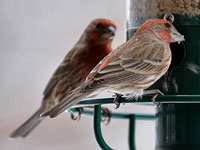 |
|
IN THIS ISSUE
Volunteer - Conservation Landscape
Tour! Merrimac Farm Wildlife Walks
Tour! Featherstone National Wildlife Refuge
1st Thursday - Soils: Creating the Medium for Plant Growth
Get to Know Backyard Birds - House Finch |
Good News!
We are thrilled to announce we exceeded our fundraising goal for the Conservation Landscape project at Merrimac Farm thanks to the support of these important people:
Tom & Joyce Andrew
Lori Bauckman-Moore
Birkett & Pamela Becker
Henry & Heidi Bibber
Alyssa Brown
Bull Run Unitarian Universalist Church
James & Suzanne Conway
Susan Coulson
Dianne Crawford
Christine Drazdowsky
Julia Flanagan
Jake Frank
Patricia Freed
Harry Glasgow
John Gray
Albert Greene
Charlie Grymes
Martha Hendley
Cathy Hindman
Timothy Horn
Kim Hosen
Ka lei Pua
Jim & Bonnie Klakowicz
Roberta Knussmann
Jeanine Lawson
Christine Learman
Mike Lewis
Kathy & Pete Madsen
Stephen & Cathy Mallinger
David Montanari
Tom Murphree
Marty Nohe
Bill Olson
Julie Phillips
Phyllis Putnam
Tim's River Shore
Rita Romano
Julia & David Sarr
Elena Schlossberg
Ernie Sears
Marcia Settle
Eileen Sheridan
Steve & Angela Tabone
R.B. Thomas
Nancy Vehrs
Erin Willenburg
Vickie Willenburg
Amelia Wilson |

Every little bit helps. It's amazing how much you can do when you choose to give a little bit of that natural habitat back.
- Roxanne Paul
|
|
| Volunteer! Merrimac Farm Conservation Landscape Prep for Fall Planting |
 Sat., August 27, 9:00 am to Noon Sat., August 27, 9:00 am to Noon
Sat., September 24, beginning at 9:00 am
We're planning to begin planting this fall... we've already removed a 100 foot row of Autumn Olives, one of the most invasive nonnative plants at Merrimac Farm, and need help now to prepare the area.
For all work days, bring a smile and a shovel, we appreciate your help! RSVP appreciated but not required to alliance@pwconserve.org, 703-499-4954. Click here for directions to the Stone House and here for more information. |
|
Soils: Creating the Medium for Plant Growth |
 1st Thursday Speaker Series 1st Thursday Speaker Series
When: Thursday, Sept. 1 from 7:30 to 9:00 p.m.
Where: Bull Run Unitarian Universalist Church, 9350 Main Street, Manassas
Speaker: Dan Schwartz, Soil Scientist, Northern Virginia Soil & Water Conservation District
How long does it take to form an inch of topsoil? Depending on climate, vegetation and geology, it can take 500 to 1,000 years or more to form one inch of soil. A long time for a little soil, consider how much has changed since the beginning of the Middle Ages.
Often overlooked or taken for granted, soil is one our our three major natural resources, with air and water.There are more living things in a gram of soil than people on the planet.
Whether you are a wildlife watcher, gardener or interested in community appearance efforts, Dan has information that's important to your success! |
|
|
| Merrimac Farm Wildlife Walk |
 When: Sunday, August 28 & Sunday, September 25, 8:00 am When: Sunday, August 28 & Sunday, September 25, 8:00 am
Where: Meet at the Stone House at Merrimac Farm, 15020 Deepwood Lane, Nokesville
Featherstone is beautiful in all seasons, perhaps especially in a wet spring, such as this spring. Please join us for a walk through this 235-acre natural area, which includes nearly two miles of Potomac River shoreline.
Everyone is welcome.
Dress for the weather, bring binoculars and cameras. More info and RSVP (appreciated not required) to PWCA , 703.499.4954 or alliance@pwconserve.org. |
|
|
| Tour! Featherstone Refuge |
 When: Saturday, Sept. 10, from 8:00 to 10:30 am When: Saturday, Sept. 10, from 8:00 to 10:30 am
Where: Meet at the Rippon VRE main parking lot, located at the end of Farm Creek Drive just past the intersection with Rippon Blvd.
Featherstone is beautiful in all seasons, perhaps especially in a wet spring, such as this spring. Please join us for a walk through this 235-acre natural area, which includes nearly two miles of Potomac River shoreline.
Everyone is welcome.
Dress for the weather, bring binoculars and cameras. More info and RSVP (appreciated not required) to PWCA , 703.499.4954 or alliance@pwconserve.org. |
|
|
|
| Get to Know Backyard Birds - House Finch |
 Back in the 1940's, flocks of a certain type of birds were sold in New York City as "Hollywood Finches". But it was already illegal to sell or possess migratory birds by then, and a lot of Hollywood Finches were freed by vendors when they thought they were about to be caught. Back in the 1940's, flocks of a certain type of birds were sold in New York City as "Hollywood Finches". But it was already illegal to sell or possess migratory birds by then, and a lot of Hollywood Finches were freed by vendors when they thought they were about to be caught.
This is how House Finches came to exist in the eastern United States. For a long time, the birds had trouble surviving in their new environment, but eventually, they grew in large numbers and began competing with the more abundant House Sparrow and the native Purple Finch.
Permanent residents in Northern Virginia, House Finches are sparrow-sized. The males have bright red feathers on the forehead, eyebrow, breast and rump. The rest of the body is streaked brown. Keep reading... |
|
|